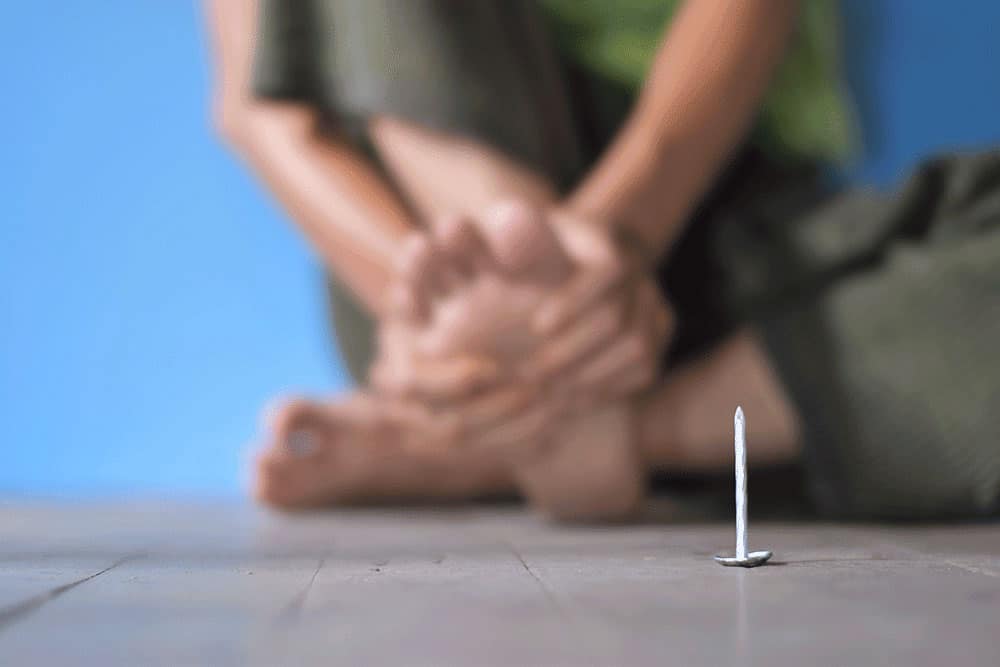
A foot puncture wound is not like a normal cut; it is a small hole in the skin caused by a pointed object, such as a nail you have stepped on.
Proper treatment within the first several hours is particularly important with puncture wounds because the piercing object may become embedded under the skin. Prompt medical attention can greatly reduce the chance of complications.
Preventing a Puncture Wound in the Foot
To avoid puncture wounds of the foot, be careful to follow these tips.
Wear appropriate socks and shoes for the occasion. Heavy-soled shoes should be worn if you’re playing or working in a place where pointed objects (nails, screws, stones, or tacks) might be scattered about.
Check the insides of your shoes before putting them on to ensure nothing fell in while they were off — pets sometimes like to hide small objects in their owners’ shoes.
Common household items like sewing needles and toothpicks are common causes of puncture wounds, so use care around the house.
If you have a condition that leaves you prone to infection — for example diabetes, immunodeficiency, or peripheral vascular disease — you are particularly at risk and should avoid going barefoot altogether.
Caring for a Puncture Wound
Puncture wound care depends on the severity and cause of the injury.
At home treatment
- Minor puncture wounds can be treated at home, and steps include:
- Wash your hands to reduce the risk of infection.
- Rinse the wound with water and use disinfected tweezers to remove debris.
- Clean the wound with soap and water, pat dry with a clean towel, apply an antibiotic and cover with a bandage.
- If the wound is bleeding, apply gentle pressure with a clean cloth or bandage.
- Change the bandage once a day.
It’s important to note that if the “foreign body” is still stuck in the skin, the wound may not bleed much or at all.
When to seek medical attention
Call 911 or visit your emergency room if there is persistent bleeding that can’t be stopped, numbness around the wound, or other serious injuries.
Call your podiatrist right away if:
- The wound is showing signs of infection (red streaks from the wound, throbbing sensation, fever, and/or swelling).
- It was caused by an animal or human bite.
- You were punctured by a dirty or rusty object.
- The wound is large or deep.
At the doctor’s office
Your foot and ankle specialist will want to know what type of sharp object caused the wound, where it happened, and if you were wearing shoes or socks.
They will then assess how deep the wound is and thoroughly clean out any debris. You might need a tetanus shot or antibiotics, depending on the cause of the wound. If the open wound was from an animal bite, your doctor might recommend rabies vaccination. An X-ray can determine if there’s any bone damage or if the foreign object is still in the wound.
Puncture wounds present a high risk for soft tissue infection and development of osteomyelitis (bone infection), so it’s important to seek follow-up care as advised by your physician.
UFAI for your foot and ankle care
UFAI is nationally recognized for the treatment of puncture wounds and diabetic foot ulcers. Our doctors have decades of combined experience in managing the special circumstances surrounding wound care. In addition, our board-certified foot and ankle surgeons are internationally recognized experts in the field of regenerative medicine to treat foot and ankle conditions.
If you are concerned about an open sore on your lower leg or foot that’s taking longer than usual to heal, you may benefit from advanced wound care by one of the foot wound experts at the University Foot and Ankle Institute (UFAI) wound care centers.
As one of Los Angeles’ largest podiatry practices, UFAI offers multi-disciplinary medical care and diagnostic testing on-site. Our patients receive maximum convenience and peace of mind with our on-site testing and treatment options.
Our podiatrists take patients’ safety seriously. Our podiatry facility’s Covid-19 patient safety procedures exceed all the CDC’s coronavirus pandemic recommendations. Masks are always required in our institutes.
University Foot and Ankle Institute is conveniently located throughout Southern California and the Los Angeles area. Our foot doctors are available at locations in or near Santa Monica, Beverly Hills, West Los Angeles, Manhattan Beach, Northridge, Westlake Village, Granada Hills, Valencia, and Santa Barbara.
Resources
Chudnofsky CR, Sebastian S. Special wounds: nail bed plantar puncture and cartilage. Emerg Med Clin. N Am. 1992;10(4):801-821.
Haverstock, B. D., & Grossman, J. P. (1999). Puncture wounds of the foot. Evaluation and treatment. Clinics in podiatric medicine and surgery, 16(4), 583–596.
Lavery LA, Harkless LB, Ashry HR, Felder-Johnson K. Infected puncture wounds in adults with diabetes: risk factors for osteomyelitis. J Foot Ankle Surg 1994; 33:561.
- Revolutionizing Extremity Imaging: UFAI’s Open MRI for the Foot and Ankle - October 21, 2023
- Youth Sports and Heel Pain: Should Kids Play with Pain? - April 4, 2023
- All About Foot Arch Pain and Foot Arch Cramps - March 15, 2021
This was an exceptionally nice post. Thank you!